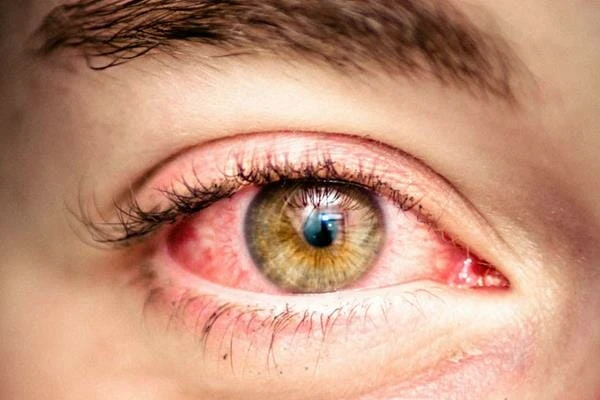Why Red Irritated Eyes?
Almost everyone has dealt with red irritated eyes. Caused by a wide variety of reasons, red eyes can happen at any time. There are many reasons that red, irritated eyes occur:
- Eye Conditions
- Air Quality
- Surgery and Medicines
- Lifestyle and Habits
- Being Female – hormone changes
Red Irritated Eyes Conditions
- Conjunctivitis – The most common cause, conjunctivitis causes the whites of the eyes to become pink or red.
- Ocular Herpes – Caused by the type 1 herpes simplex virus, ocular herpes causes cold sores on the eyes resulting in inflammation and scarring of the cornea.
- Ocular Rosacea – A reddening of the whites of the eyes, ocular rosacea mainly affects people between 30 and 60 years of age. Those with fair skin and light colored hair and eyes and women in menopause tend to develop ocular rosacea over other groups.
- Iritis – Anterior uveitis (Iritis) is an inflammation of the iris where small white blood cells from the affected area along with excess protein float inside the fluid that sits between the iris and the cornea.
- Eye Styes – An inflammation or infection of the follicle of an eye lash or a meibomian gland that is located along the eyelid edge. Presented as a red, painful lump, these “pimple like” areas are contagious. A chalazion is similar but not contagious. Both are caused by clogged Meibomian glands.
Environmental Factors Cause Red Irritated Eyes
Seasonal and food allergies, climate, and smoking can cause eyes to become red and irritated. Thirty to forty percent (30-40%) of Americans have seasonal or food allergies. Many people exposed to smoke, whether from a smoker or burning material, develop eye discomfort also.
- Allergies and Sensitivities – Whether seasonal or chronic, allergy sufferers and those who have sensitivities to certain issues such as rheumatoid arthritis or even depression can develop red eyes. Eighty percent of people with allergies develop eye allergies.
- Weather – When the wind blows, the dry environmental conditions can dry out the delicate fluid layer that protects the eyes. A dry climate can also cause red eyes to worsen.
- Smoking – Not only bad for a person’s health, smoking can worsen dry, red, irritated eyes. Avoiding smoke can help, but if the smoke is in the environment, it may not be avoidable.
Eye Surgery and Medication Causing Red Irritated Eyes
LASIK surgery is a popular option for those wanting better vision. However, any eye surgery can damage nerve fibers or disrupt the tear film leading to dry eyes and red irritated eyes.
Certain drugs such as antihistamines, sleeping pills, and anti-anxiety medications can restrict blood flow to the eyes making red irritated eyes
Lifestyle Habits That Can Reduce Red Irritated Eyes
Excessive computer or mobile phone usage can cause users to blink less which leads to red irritated eyes and dry eyes. Eye strain from extended computer usage is also a common problem. Fatigue can leave the eyes sore and irritation. Rest your eyes 5 minutes every hour, and limit electronic usage within an hour before bedtime.
Gender
Being a woman presents particular issues such as menopause, menstrual cycles, and pregnancy that can cause red irritated eyes and dry eye symptoms.
- Menopause – Lowered estrogen levels can lead to worsening dry eye symptoms.
- Menstrual Cycle – Higher estrogen levels during the first phase of a menstrual cycle can worsen red and dry eye symptoms.
- Pregnancy – Changing hormones occurring during pregnancy can also worsen dry and red eye symptoms.
The TheraLife Solution for Red Irritated Eyes
As a leader in chronic dry eye relief, TheraLife goes directly to the source of the problem of red irritated eyes. A natural chronic dry eye solution, TheraLife addresses the fundamental cause of dry eyes: underactive tear secretion. Targeting the issue from the inside out, TheraLife provides natural dry eye relief by promoting the body’s own healing tears.
TheraLife aids the body in natural tear production and ends reliance on eye drops which can contribute to chronic dry eyes making more red irritated eyes. By ending the reliance on eye drops, comfortable vision is restored naturally.
Stop wasting time on treatments that fail to address the root cause of dry eye problems. Try TheraLife today for a natural solution to dry eyes.
To learn rmore
Call and talk to a doctor toll-free 1-877-917-1989 US/Canada. International call (650) 949-6080. Send email inquiries to [email protected]
REFERENCES
1. Petersen I, Hayward AC. Antibacterial prescribing in primary care. J Antimicrob Chemother. 2007;60(suppl 1):i43–47.
2. Høvding G. Acute bacterial conjunctivitis. Acta Ophthalmol. 2008;86(1):5–17.
3. Wirbelauer C. Management of the red eye for the primary care physician. Am J Med. 2006;119(4):302–306.
4. Leibowitz HM. The red eye. N Engl J Med. 2000;343(5):345–351.
5. Galor A, Jeng BH. Red eye for the internist: when to treat, when to refer. Cleve Clin J Med. 2008;75(2):137–144.
6. Rietveld RP, ter Riet G, Bindels PJ, et al. Predicting bacterial cause in infectious conjunctivitis. BMJ. 2004;329(7459):206–210.
7. Rose PW, Harnden A, Brueggemann AB, et al. Chloramphenicol treatment for acute infective conjunctivitis in children in primary care. Lancet. 2005;366(9479):37–43.
8. Rietveld RP, van Weert HC, ter Riet G, et al. Diagnostic impact of signs and symptoms in acute infectious conjunctivitis. BMJ. 2003;327(7418):789.
9. Everitt HA, Little PS, Smith PW. A randomised controlled trial of management strategies for acute infective conjunctivitis in general practice [published correction appears in BMJ. 2006;333(7566):468]. BMJ. 2006;333(7563):321.
10. Wagner RS, Aquino M. Pediatric ocular inflammation. Immunol Allergy Clin North Am. 2008;28(1):169–188.
11. Buznach N, Dagan R, Greenberg D. Clinical and bacterial characteristics of acute bacterial conjunctivitis in children in the antibiotic resistance era. Pediatr Infect Dis J. 2005;24(9):823–828.
12. Morrow GL, Abbott RL. Conjunctivitis. Am Fam Physician. 1998;57(4):735–746.
13. Azar MJ, Dhaliwal DK, Bower KS, et al. Possible consequences of shaking hands with your patients with epidemic keratoconjunctivitis. Am J Ophthalmol. 1996;121(6):711–712.
14. Fay A. Diseases of the visual system. In: Goldman L, Ausillo D, eds. Cecil Medicine. 23rd ed. Philadelphia, Pa.: Saunders; 2007.
15. American Academy of Ophthalmology. Preferred practice patterns. Conjunctivitis. September 2008. http://one.aao.org/CE/PracticeGuidelines/PPP.aspx. Accessed September 3, 2009.
16. Sheikh A, Hurwitz B. Antibiotics versus placebo for acute bacterial conjunctivitis. Cochrane Database Syst Rev. 2006(2):CD001211.
17. Sheikh A, Hurwitz B. Topical antibiotics for acute bacterial conjunctivitis. Br J Gen Pract. 2005;55(521):962–964.
18. Sheikh A, Hurwitz B. Topical antibiotics for acute bacterial conjunctivitis: a systematic review. Br J Gen Pract. 2001;51(467):473–477.
19. Wickström K. Acute bacterial conjunctivitis—benefits versus risks with antibiotic treatment. Acta Ophthalmol. 2008;86(1):2–4.
20. Block SL, Hedrick J, Tyler R, et al. Increasing bacterial resistance in pediatric acute conjunctivitis. Antimicrob Agents Chemother. 2000;44(6):1650–1654.
21. Goldstein MH, Kowalski RP, Gordon YJ. Emerging fluoroquinolone resistance in bacterial keratitis. Ophthalmology. 1999;106(7):1313–1318.
22. Little P, Gould C, Williamson I, et al. Reattendance and complications in a randomised trial of prescribing strategies for sore throat. BMJ. 1997;315(7104):350–352.
23. Trimethoprim-polymyxin B sulphate ophthalmic ointment versus chloramphenicol ophthalmic ointment in the treatment of bacterial conjunctivitis J Antimicrob Chemother. 1989;23(2):261–266.
24. Jauch A, Fsadni M, Gamba G. Meta-analysis of six clinical phase III studies comparing lomefloxacin 0.3% eye drops twice daily to five standard antibiotics in patients with acute bacterial conjunctivitis. Graefes Arch Clin Exp Ophthalmol. 1999;237(9):705–713.
25. Lohr JA, Austin RD, Grossman M, et al. Comparison of three topical antimicrobials for acute bacterial conjunctivitis. Pediatr Infect Dis J. 1988;7(9):626–629.
26. Protzko E, Bowman L, Abelson M, et al. Phase 3 safety comparisons for 1.0% azithromycin in polymeric mucoadhesive eye drops versus 0.3% tobramycin eye drops for bacterial conjunctivitis. Invest Ophthalmol Vis Sci. 2007;48(8):3425–3429.
27. Bielory L, Friedlaender MH. Allergic conjunctivitis. Immunol Allergy Clin North Am. 2008;28(1):43–58.
28. Granet D. Allergic rhinoconjunctivitis and differential diagnosis of the red eye. Allergy Asthma Proc. 2008;29(6):565–574.
29. Schaumberg DA, Sullivan DA, Buring JE, et al. Prevalance of dry eye syndrome among U.S. women. Am J Ophthalmol. 2003;136(2):318–326.
30. Jackson WB. Blepharitis: current strategies for diagnosis and management. Can J Ophthalmol. 2008;43(2):170–179.
31. Tomlinson A, Khanal S, Ramaesh K, et al. Tear film osmolarity: determination of a referent for dry eye diagnosis. Invest Ophthalmol Vis Sci. 2006;47(10):4309–4315.
32. American Academy of Ophthalmology. Preferred practice patterns. Dry eye syndrome. http://one.aao.org/CE/PracticeGuidelines/PPP.aspx. Accessed September 3, 2009.
33. American Academy of Ophthalmology. Preferred practice pattern. Blepharitis. http://one.aao.org/CE/PracticeGuidelines/PPP.aspx. Accessed September 3, 2009.
34. Tullo A. Pathogenesis and management of herpes simplex virus keratitis. Eye. 2003;17(8):919–922.
35. Turner A, Rabiu M. Patching for corneal abrasion. Cochrane Database Syst Rev. 2006(2):CD004764.
36. Williams CP, Browning AC, Sleep TJ, et al. A randomised, double-blind trial of topical ketorolac vs artificial tears for the treatment of episcleritis. Eye. 2005;19(7):739–742.





